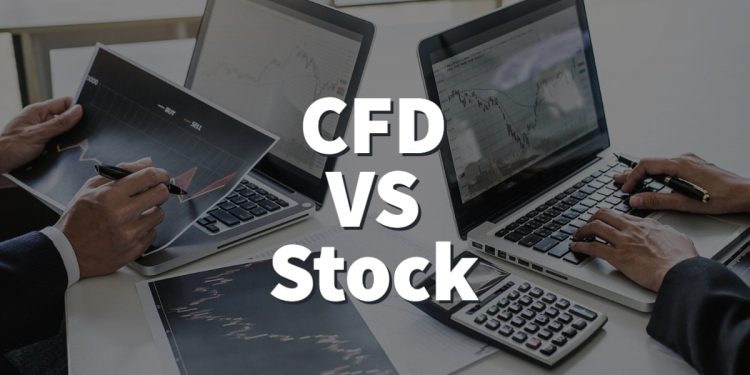CFD vs. Stock: Which is Better for Trading and Why Exactly?
Have you ever compared CFD vs. Stock to see which is better for trading? Do you need clarification on which one would the the perfect choice for you to trade? And, ultimately, if there’s a better option, why is that so?
First, trading CFDs and stocks is fun, exciting, and challenging since we are talking about very volatile and dynamic financial markets. Every day, the competition increases more and more, making it both tempting and difficult to trade, which will generate serious profits.
However, to make a CFD vs. STOCK comparison most sufficiently, it would be best to explain each concept individually and then compare it with all the information obtained.
Well, let’s start with CFDs first, shall we?
What does the CFD mean exactly?
A Contract for Difference, shortened “CFD”, refers to a specific agreement between an investor and a broker to settle the difference in the value of an asset from when the contract starts to when it closes.
While stock trading involves buying or selling actual shares on stock exchanges, CFD trading lets investors speculate on price movements without possessing the asset.
CFD trading as a sophisticated approach
CFD trading is a sophisticated approach typically reserved for seasoned traders. Unlike traditional trades, CFDs don’t involve transfer of tangible assets. Instead, the investor earns or loses based on the asset’s price fluctuation.
For instance, an investor predicts its price movement rather than trading tangible gold. Essentially, CFDs let investors forecast the price trajectory of an asset.
When a CFD holder sees a price upswing, they might liquidate their position. The profit or loss is calculated by the difference between entry and exit prices, processed through the investor’s trading account.
What is Stock?
A stock, often termed equity, represents a stake in a company, allowing the holder to claim a portion of the company’s assets and earnings proportional to their share price. This share price can rise and fall based on various market factors.
Stocks are mainly traded on stock exchanges and form a crucial part of many individual’s investment portfolios. It’s essential to know that trading stocks must adhere to specific regulations to safeguard investors from fraudulent activities.
Delving into Stock Ownership
Upon opening a position in a company’s stocks, a stockholder is regarded as a proprietor of that company. This ownership is gauged by the fraction of their total available shares.
For example, if a business has 1,000 shares circulating and an individual holds 100, this individual lays claim to 10% of the business’s resources and profits. Implementing a “stop loss” can be a strategic move for these stockholders to mitigate potential losses in this financial instrument.
Corporate Entities and Shareholders
While stockholders hold a stake in a corporation, they don’t possess it outright. As distinct financial instruments, corporations are unique entities recognized by law as distinct entities with legal personhood. They can own assets, incur debts, file taxes, and face lawsuits.
Hence, equipment like desks in a corporate building is the corporation’s property, not those who’ve opened positions in its stocks.
Asset Protection and Liability
The assets of a corporation are distinctly separate from its shareholders, offering a shield that limits financial responsibility. If a corporation faces insolvency, its assets might be liquidated by court order, but a shareholder’s assets remain untouched.
Shareholders might see a dip in share value, but using tools like “stop loss” can be a safeguard. If a principal shareholder faces financial ruin, the corporation’s assets stay protected from creditors.
What are financial derivatives?
On the other hand, financial derivatives are contracts whose value is based on an underlying asset, like stocks, bonds, or commodities.
Unlike stocks, where one holds a piece of the company, derivatives derive their value from these assets, enabling investors to speculate on the asset’s future price movements without actually owning it. They offer flexibility and can be used for hedging or taking on more risk, depending on an investor’s strategy.
Shareholder Stake Explained
Shareholders hold shares issued by a corporation, not the company’s assets. Holding 33% of shares doesn’t mean you own a third of the company, but it emphasizes the difference between ownership and control.
Having shares grants voting rights, entitlement to dividends, and the freedom to transfer them. If you hold the majority, you influence the company’s direction by selecting its board. This dynamic is clear when one firm buys another.
The board’s role is to boost corporate value, often by employing expert managers like the CEO. Typical shareholders don’t oversee operations. Your stake as a shareholder denotes your share of profits and, thus, a stock’s value. While many stocks reinvest profits instead of distributing dividends, these earnings still affect the stock’s worth.
Get the CFD vs. Stock Trading Comparison
CFDs allow investors to profit from the difference between an asset’s opening and closing price.
The focus isn’t on the actual CFD price vs stock price but the price change.
In stock trading, investors own a piece of the company they buy shares in, making them shareholders.
Comparison: CFDs vs. Stocks
Ownership
– CFDs: None
– Stocks: Yes
Use of Leverage (Borrowed Funds)
– CFDs: Available
– Stocks: Not Available
Buying & Selling Positions
– CFDs: Both long and short positions allowed
– Stocks: Allowed; however, short selling is more intricate
Markets Available for Trading
– CFDs: Diverse sectors
– Stocks: Primarily shares and ETFs
Trading Costs
– CFDs: Spread & Overnight Maintenance Fees
– Stocks: Brokerage Fee
Operational Hours
– CFDs: Continuous, 5 days a week
– Stocks: Confined to stock market hours
Dividend Earnings
– CFDs: Via monetary adjustment
– Stocks: Yes
Potential Losses
– CFDs: Can exceed the initial investment
– Stocks: Limited to the invested amount
Voting Rights
– CFDs: None
– Stocks: Granted
Trade CFDs vs. Stocks:
Advantages: CFDs offer lower initial costs than buying stocks outright, flexibility to go long or short sell, and easy trade execution. CFDs vs. stocks can also bypass some restrictions present in stock exchanges. Disadvantages: CFDs present immediate margin requirements, reduce the initial position, and have associated risks like weak regulation and liquidity issues.
Trading Strategy Insights:
CFD trading requires a distinct strategy. Experienced CFD traders speculate on price movements, betting on either an increase (going long) or a decrease (going short) in value. The gains or losses from CFDs are settled through the trader’s account. For instance, if speculating on gold’s movement, one wouldn’t physically buy or sell gold but speculate on its price movement.Key Considerations:
Stock vs. CFD: The buying or selling in stock trading is transparent on stock exchanges, whereas CFD trading does not involve actual asset ownership. The buy price in stock trading is the asset’s actual cost, whereas, in CFDs, it’s based on predictions. While CFDs offer a means to capitalize on short-term price movements, stocks provide dividends and longer-term growth potential.CFD Trading vs Stock Trading: An Overview
Imagine you’re interested in purchasing Apple stock with a bid-ask spread of $156.25/$156.29.
Acquire 10 shares at $156.29, amounting to $1,562.90. Conversely, opt for 10 CFDs at $156.29 with a 10% margin deposit, which comes to $156.29.Is CFD Trading Riskier?
Leverage can amplify risks. For instance, if you deposit a 10% margin for a trade, a mere 10% drop in share price can wipe out your deposit.
But you can also add funds to meet margin calls. Be cautious, as losses can sometimes surpass the deposited margin.
Which is More Cost-effective: CFD or Stock Trading?
Trading CFDs entails costs like the spread, potential commissions, and overnight charges. Stock trades include stock exchange spreads, custody fees, and occasional commissions but not overnight charges.
With the advent of commission-free trading, stock trading costs now closely align with CFD trading costs. Your holding period for the trade is key in assessing costs.
What are the main benefits?
Leverage: Enables trading larger positions with less capital, increasing potential risks and rewards. Simplicity in Trading: Click ‘buy’ to go long on a stock CFD and ‘sell’ to go short. Market Diversity: CFDs allow trading across major asset classes like stocks, forex, commodities, and indices. Extended Hours: CFD trading is usually 24 hours, accommodating global traders. Stock CFDs typically adhere to stock market timings.Bottom Line
While CFD and stock trading offer avenues to profit from the financial markets, they come with different approaches, benefits, and risks. Traders must understand these distinctions before venturing into either.
Hope you liked the CFD vs Stocks comparison and that it helped you pick one to trade! Good luck!
FAQ
What is a CFD in trading?
A CFD allows speculation on price changes without owning the actual asset.
How does stock trading differ from CFD trading?
Stock trading involves buying actual company shares, while CFDs focus on price fluctuations.
Do CFD traders own assets or receive dividends?
CFD traders don’t own the asset and receive dividends via monetary adjustments.
Is CFD trading riskier?
Due to leverage, CFD trading can amplify potential losses and gains.
Which is more cost-effective, CFD or stock trading?
Costs vary; CFDs have spreads and overnight charges, while stocks have exchange spreads and custody fees. The holding period also affects cost-effectiveness.
The post CFD vs. Stock: Which is Better for Trading and Why Exactly? appeared first on FinanceBrokerage.














